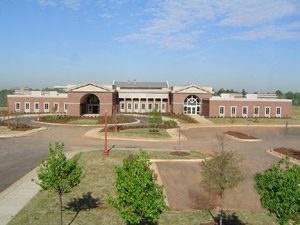
TUSCALOOSA, Ala. – The University of Alabama’s University Medical Center opens today on the corner of Fifth Avenue East and University Boulevard. The Center is the only multi-specialty clinic in Tuscaloosa.
Groundbreaking for the $13.5 million 77,000 square foot facility took place on Nov. 24, 2002. Dr. William Curry, physician and dean of the College of Community Health Sciences, University of Alabama School of Medicine, Tuscaloosa, said the new facility will help consolidate CCHS faculty, students and services into one building from the four they have occupied in the past.
“Our dream has become a reality,” Curry said. “We’ve been waiting for the time when we could house all of the College under one roof. That time has come, and we’re looking forward to offering quality care and service to the community and surrounding areas.”
The new facility offers medical care for all ages and has many special services: family medicine; pediatrics, including an ADHD clinic and follow-up care for infants who were in neonatal intensive care after birth; internal medicine; neurology; obstetrics and gynecology; and mental health services in the Betty Shirley Clinic for Psychiatry and Behavioral Medicine, which offers individual counseling, marriage and family counseling, psychiatric outpatient care, psychotherapy and drug therapy.
Lab testing and X-rays are completed on-site and nutrition therapy and dietary information are available for patients who need help managing diabetes, obesity and other medical conditions. Social services and a prescription drug assistance program also are provided.
The new building has a state-of-the-art medical information system. The paperless system makes it easier to improve education and clinical efficiency while providing the best possible care to patients. Curry said the students and residents involved in CCHS’s program will have had experience in the medical office of the future, which will be essential during their years of medical practice.
“Our country is reaching a crisis in care involving family practice, especially in rural communities,” Curry added. “The paperwork, heavy workload and lower incomes associated with primary care and family medicine can make family practice less attractive for young doctors. We’re doing all we can to make primary care and family practice both high-tech and high touch. That gives patients and families what they most need and demand from today’s complex health care system.”
The UA School of Medicine’s Tuscaloosa branch campus plans to accomplish that vision by providing better ways of managing information, reducing costs and linking educational resources to the doctor-patient visit. UA’s program is the first in the state to take such a comprehensive approach.
The UA School of Medicine has the responsibility for the clinical education of junior and senior medical students. Its family practice residency is one of the oldest, largest and most productive in the Southeast.
The College has made significant strides in making health care more available and accessible across the state of Alabama. More than 450 physicians have received their third- and fourth-year clinical training at CCHS. Of those graduates, 52 percent have chosen careers in primary care.
In addition, more then 300 family practitioners have completed their three-year residency training at UA. One in seven family physicians in Alabama graduated from this residency program.
CCHS addresses the unique need of training medical students and residents to practice in smaller communities in the more rural areas of Alabama. The mission of the College is to provide physicians with the expertise of accessible, high quality and compassionate medical care for the citizens of Alabama through education, research and service.
CCHS is one of three clinical campuses of The University of Alabama School of Medicine, a nationally ranked medical center established in Birmingham in 1945.
Contact
Elizabeth M. Smith, UA Media Relations, 205/348-3782, esmith@ur.ua.edu
Source
Dr. William Curry, 205/348-1288Linda Jackson, 205/348-1302